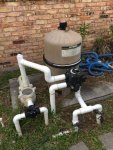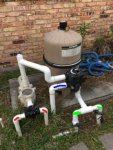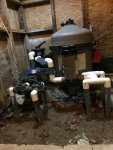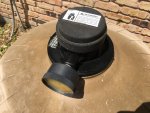Hi everyone
First off, thanks for reading and helping me. This forum is amazing, full of a ton of information, and I know I'm just starting to scratch the surface. That said, here's where I stand:
We purchased a house about 4 years ago (TX area) with an in ground, approx 35,000 gallon pool built in the mid 1970s. Goes from ~4' to 9' (maybe 10). It was clearly resurfaced some number of years ago, and clearly will need to be redone in the next few years. Previous owners did a lot of things themselves to a pretty low degree of success around the rest of the house, so I full expect that whatever they did with the pool and equipment to be par with that. We have a pool guy that does a bunch of other pools on the street - charges ~$40/week, and from what I can tell all he does is toss a few chlorine tabs in every week and vacuum it with a long pole and the flat 6"x12" vacuum attachment. Wham bam $162.37/month thank you ma'am. I'm super handy and this is my first pool - but I know I can do what he does and save myself some cash. We also have a Polaris 360 pressure cleaner thing, of which I've replaced every single internal part, and I'm sick of it. What a piece of junk.
Recently we've noticed a ton of dark grey grit in the pool - Mr Cleaner Guy says we need to replace our DE filters, but the more I read about it the more I'm convinced I can just clean and recharge the DE system, and not have to spring for new filters and all of his labor costs. I'm also thinking that if I can dump the guy, a nice shiny robotic vacuum cleaner pays for itself by mid summer.
Here's where I'm stuck: I'm super intimidated to crack open the pump/filter/etc unit without really understanding what I'm looking for. I know there are certain pressures and levels I'll need to watch, but other than that I'm worried about getting stuck and having to throw a few hundred dollars (or more) at Mr Cleaner to fix it. Since I'd be removing the Polaris pressure cleaner, I know I'd be messing with the water volumes in/out of the system, so I want to make sure I'm doing things right (unlike my predecessor).
So my questions:
1) There's 5 PVC ports going down into the ground. Where is water flowing to/from? I know I have:
a) A drain at the bottom of the pool (suction)
b) A skimmer at the surface of the pool (suction)
c) A small nozzle pushing (presumably clean) water into the pool (pressure)
d) A large hose pressurizing the Polaris 360 (pressure)
e) A drain which pumps pool water into the sewer
f) The pool is filled manually, by me or a big rain storm.
I know turning the large black handle on the right so the valve is pointing to the right drains the pool. I had to do that a few times during some bad storms to prevent the pool from overflowing. Otherwise I don't know what is going where.
2) Does converting from a Polaris 360 to a robot cleaner change anything about what water needs to go where? Essentially, can I leave all the valve switches where they are and just come home to a nice clean pool every day? Seems weird that we would have 2 nozzles pumping water into the pool, but then again I guess we have ports draining the water, so from a volume perspective maybe it is what it is.
3) Right now we're running the Polaris for 4-8 hours a day (depending on the season). Due to the large size of the pool, does the robot need to run as long?
4) Chemicals: Though the cleaner guy is clearly taking the easy route, to be honest the pool has always had a great chemical balance since we moved in. So from what I can tell his methods are a bit unorthodox, but it's been working. Do I mess with what works?
Again, thanks for any and all advice. Let me know what other info would be helpful and I'll provide it as quickly/completely as I can.
First off, thanks for reading and helping me. This forum is amazing, full of a ton of information, and I know I'm just starting to scratch the surface. That said, here's where I stand:
We purchased a house about 4 years ago (TX area) with an in ground, approx 35,000 gallon pool built in the mid 1970s. Goes from ~4' to 9' (maybe 10). It was clearly resurfaced some number of years ago, and clearly will need to be redone in the next few years. Previous owners did a lot of things themselves to a pretty low degree of success around the rest of the house, so I full expect that whatever they did with the pool and equipment to be par with that. We have a pool guy that does a bunch of other pools on the street - charges ~$40/week, and from what I can tell all he does is toss a few chlorine tabs in every week and vacuum it with a long pole and the flat 6"x12" vacuum attachment. Wham bam $162.37/month thank you ma'am. I'm super handy and this is my first pool - but I know I can do what he does and save myself some cash. We also have a Polaris 360 pressure cleaner thing, of which I've replaced every single internal part, and I'm sick of it. What a piece of junk.
Recently we've noticed a ton of dark grey grit in the pool - Mr Cleaner Guy says we need to replace our DE filters, but the more I read about it the more I'm convinced I can just clean and recharge the DE system, and not have to spring for new filters and all of his labor costs. I'm also thinking that if I can dump the guy, a nice shiny robotic vacuum cleaner pays for itself by mid summer.
Here's where I'm stuck: I'm super intimidated to crack open the pump/filter/etc unit without really understanding what I'm looking for. I know there are certain pressures and levels I'll need to watch, but other than that I'm worried about getting stuck and having to throw a few hundred dollars (or more) at Mr Cleaner to fix it. Since I'd be removing the Polaris pressure cleaner, I know I'd be messing with the water volumes in/out of the system, so I want to make sure I'm doing things right (unlike my predecessor).
So my questions:
1) There's 5 PVC ports going down into the ground. Where is water flowing to/from? I know I have:
a) A drain at the bottom of the pool (suction)
b) A skimmer at the surface of the pool (suction)
c) A small nozzle pushing (presumably clean) water into the pool (pressure)
d) A large hose pressurizing the Polaris 360 (pressure)
e) A drain which pumps pool water into the sewer
f) The pool is filled manually, by me or a big rain storm.
I know turning the large black handle on the right so the valve is pointing to the right drains the pool. I had to do that a few times during some bad storms to prevent the pool from overflowing. Otherwise I don't know what is going where.
2) Does converting from a Polaris 360 to a robot cleaner change anything about what water needs to go where? Essentially, can I leave all the valve switches where they are and just come home to a nice clean pool every day? Seems weird that we would have 2 nozzles pumping water into the pool, but then again I guess we have ports draining the water, so from a volume perspective maybe it is what it is.
3) Right now we're running the Polaris for 4-8 hours a day (depending on the season). Due to the large size of the pool, does the robot need to run as long?
4) Chemicals: Though the cleaner guy is clearly taking the easy route, to be honest the pool has always had a great chemical balance since we moved in. So from what I can tell his methods are a bit unorthodox, but it's been working. Do I mess with what works?
Again, thanks for any and all advice. Let me know what other info would be helpful and I'll provide it as quickly/completely as I can.





